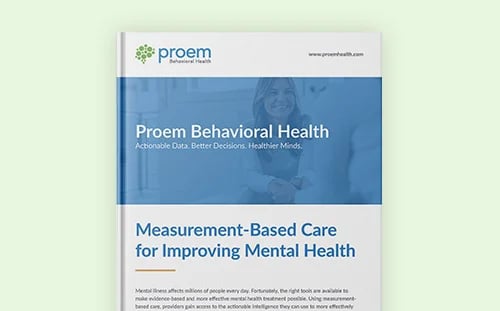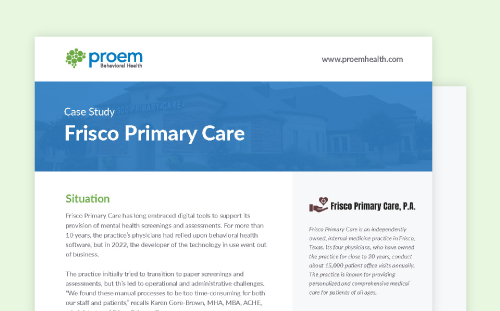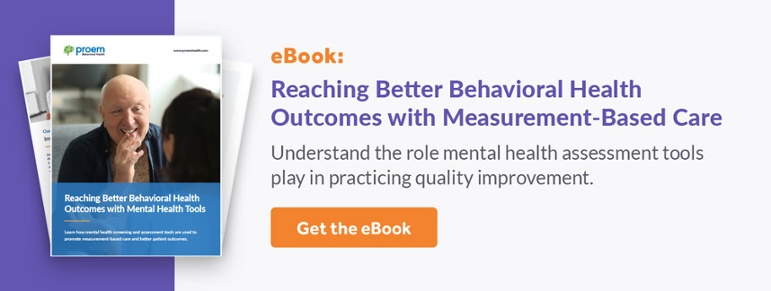
It’s largely accepted that to deliver optimal mental healthcare services, organizations must pursue evidence-based practices, measure progress and outcomes, and adapt care plans as needed. But planning to do such activities is not enough to ensure a behavioral health organization will successfully execute in these areas and maintain a high level of performance over time.
But what can be done to help behavioral healthcare providers accomplish these crucial goals that contribute to better mental health outcomes for patients? Enter quality improvement.
Interested in how to select the right tools for an accurate diagnosis? Uncover the obstacles to early intervention and proactive care with our eBook Reaching Better Behavioral Health Outcomes.
What is Quality Improvement in Healthcare?
The Centers for Medicare & Medicaid Services (CMS) defines quality improvement as “the framework used to systemically improve care.” Quality improvement in healthcare aims to standardize processes and structure to:
- reduce variation;
- achieve predictable results; and
- improve outcomes for patients.
The work that goes into developing systems that will decrease variation and strengthen outcomes naturally relies on measurement. Within behavioral health, clinicians must be able to measure initial symptom level, changes with treatment, and outcomes, among other areas, to inform best practices and identify opportunities for improvement.
Quality Improvement Tools in Healthcare: Systems of Measurement
Behavioral health measures greatly rely on the use of self-report assessments as behavioral health lacks the observable and quantifiable vital signs that are available to other medical specialties (e.g., measurement of cardiac health using heart rate and blood oxygenation level). Examples of widely accepted self-report data in behavioral health measurement may include information gathered through tools like screeners, diagnostic interviews and monitors that track behavioral experience or frequency of behaviors. Ideally, the collection of this self-report data, combined with consistent care practices that include clinical follow-up, should be useful to predict outcomes at the patient population level. In addition, data should better allow clinicians to identify and then take the most appropriate steps that will lead to better decisions and healthier minds. As such, data collection needs to be reliable, easy to interpret and easy to scale.
Measurement-based care (MBC) in behavioral health includes four components:
- Administration of validated self-report measures to patients before treatment sessions
- Clinician review of numerical and graphical scores over time
- Feedback on this data back to patients
- Collaborative evaluation of the results to determine maintenance or change in treatment course
How to Measure Quality Improvement in Healthcare
When measurement-based care is put into practice, the results can be powerful. MBC appears to affect the course of treatment through the monitoring of symptoms, which enhances clinical judgments and patient-provider communications.
Researchers have found significant quality improvement when measurement-based care is embedded in existing technologies and incorporated into the overall culture of the treatment setting. MBC provides insight into treatment progress, highlights ongoing treatment targets, reduces symptom deterioration and improves patient outcomes. MBC also serves as a framework to guide treatment decisions.
As behavioral healthcare providers adopt the same measures and systems for measurement, it becomes easier to develop evidence-based practices across patient populations and determine the systems for meaningful quality improvement.
The Quality Improvement Process in Practice
Efforts to identify optimal quality measures in behavioral health and create a framework for improvement are being led by government organizations like the U.S. Department of Health & Human Services’ Substance Abuse and Mental Health Services Administration (SAMHSA) and private companies like nView Health.
The Office of Management and Budget (OMB) has approved the use of technical specifications and data-reporting templates to collect the 32 quality measures listed in the certified community behavioral health clinics (CCBHCs) certification criteria. CCBHCs and their states are required to collect 21 of the measures for SAMHSA’s demonstration program. In addition to increasing consistent use of evidence-based practices and solutions like nView, the program is also designed to integrate behavioral health with physical healthcare and improve access to care.
Much of this work is still being shaped. Some organizations, such as the National Committee for Quality Assurance (NCQA), feel the measures continue to have significant shortcomings. In Behavioral Health Quality Framework: A Roadmap for Using Measurement to Promote Joint Accountability and Whole-Person Care, the NCQA notes:
- Federal programs, especially those focused on behavioral healthcare, rely heavily on metrics and non-standardized quality measures, limiting use for benchmarking and value-based payment models.
- Standardized behavioral health quality measures used in federal programs focus on narrowly specified conditions or processes and are misaligned and used variably across programs.
- Behavioral health integration is inconsistently and insufficiently measured by current standardized measures.
While there is much work left to finalize quality improvement metrics, clinicians can and should begin taking steps toward launching and supporting quality improvement projects at their own organizations.
Clinician's View of Quality Improvement
As the industry continues to identify the best metrics and framework to use for behavioral health quality improvement, clinicians can best prepare by taking the following steps.
- Incorporate the constructs of measurement-based care into their care processes. Introducing use of universally accepted self-report screeners and structured assessment interviews will help providers become more comfortable with using data to screen, monitor and communicate treatment progress.
- Use outcomes-based measures to track progress. The main benefit of outcomes measures is that they are results focused. When choosing measures, always look for those that support standardization, comparability, availability, timeliness, relevance, validity, stability and credibility.
- Seek electronic solutions for tracking and monitoring progress. Quality improvement efforts depend on the ability to track and analyze large quantities of data and do so over time. Organizations that adopt systems to collect and gain insights around behavioral health data for internal quality improvement projects will be better positioned to bring about meaningful improvements and manage the digital requirements for participation in payer quality improvement and value-based programs going forward.
These foundations will serve clinicians well as they make the transition to evidence-based practices, regardless of current participation in formal programs.
Achieving Quality Improvement with Evidence-Based Behavioral Health Tools
nView provides organizations with a behavioral health solution and supporting tools that power gold-standard measurement-based care. nView combines screeners, interviews, clinical follow-up functionality and scales that allow providers to make appropriate decisions that lead to better, reproducible mental health outcomes for patients. To learn about nView and how it can help your organization achieve its quality improvement goals, visit nview.com and schedule a demo.





.png)









